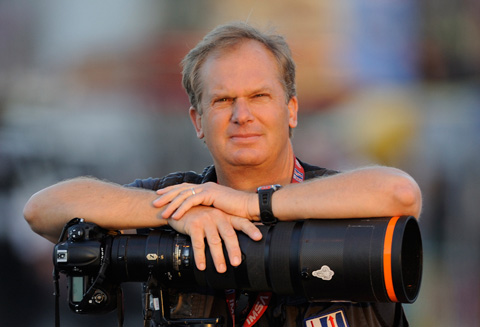
Thank you Scott and Brad for inviting me to be the guest blogger this week. It is quite an honor.
I have photographed a wide variety of sports throughout my 25 year career including the Olympics, U.S. Open and French Open tennis, PGA Tour golf and college football. However, I am probably best known as a motorsports photographer, which typically represents about 70% of my corporate and editorial work in any given year. With the racing season now in full swing I thought I would offer some insights on how I approach a typical assignment.
Most of my 2011 racing season will be spent covering endurance sports car racing – these are high-tech, multi million dollar prototype cars with the typical race lasting between 6 and 24 hours. The 12 Hours of Sebring and the 24 Hours of Le Mans are two of the best known sports car races. LeMans is the Indy 500 or the Daytona 500 of sports car racing.
I prefer shooting sports car racing for a number of reasons. The venues are great – whether shooting in Monterey, California or Imola, Italy – no two tracks looks the same. The tracks are road courses, so the cars turn left and right, and go up and down hills. Le Mans, for example, is 8.5 miles long and much of the track are public roads through the French countryside. And the races take place rain or shine. Shooting in great, magical light is the norm, especially at the longer races. At the 24 Hours of Le Mans, the sun sets around 9:45 and rises at 5:45. These races give the photographer a rich, ever changing palette. Locations are only limited to your imagination.
My kit for most assignments consists of three Nikon D3s bodies, a 500mm f/4, 70-200mm f/2.8, 50mm f/1.4, 24-70mm f/2.8, 14-24mm f/2.8, two 1.4x tele-converters, two SB-800 flashes, two 77mm circular polarizer filters, a 52mm drop in polarizer, a Singh-Ray Vari-ND filter (1-8 stops of neutral density, two spare camera batteries, and a Nikon remote trigger. All of this gear, with the exception of one camera body and one flash, is carried in a Think Tank International Roller (yes it all fits!); and the other body and flash go into a Think Tank Airport Check In along with my laptop, card readers, and external drive. I carry both of these bags on board, so if my luggage gets lost, I can still work. My checked luggage carries a monopod, battery chargers, magic arms, super clamps, and radio slaves.
Photo Mechanic and Photoshop are the two most used programs on my MacBook Pro (15 inch, anti-glare Matte screen). I use three different online photo library systems, depending on my client’s needs – Photoshelter, PhotoCore, and MagImagebank – and charge every client for the space they use on these systems.
I feel the key to good photography is location. I always try and scout every track, even if I have been there 30 times before. And quite often my scouting is from the public viewing areas or something off the beaten path. Photographers David Burnett and Bernard Asset were big influences early in my career. Burnett said if 50 photographers were in the same location looking the same way, he would turn in the opposite direction and seek out an angle others did not see. Frenchman Bernard Asset thinks much the same way. He is like a sniper, working alone away from the pack of other shooters, but returns at the end of each event with killer images. So part of my scouting routine is to seek unexpected, undiscovered locations – which could be in the middle of the woods, the top of a building, or simply driving my SUV to a spot and standing on the roof for a different perspective. The dented roof is well worth the results.
I also feel it is important to tell a complete story with my images. Motorsports photography is far more than shooting cars on the track. It is important that my photographs give the viewers a sense of place, a feel for the ambiance, and insight to the people who encompass this sport.
I receive a lot of questions regarding technique. I have some general rules, but like every rule in photography, I break them all of time. But here are a few guidelines.
a) When shooting head on or font 3/4 car shots, the aperture needs to be at f/6.3 or f/8 to insure the front of the nose to the drivers helmet is sharp. This is important when shooting for corporate clients who want to see their sponsor logos clearly.
b) The majority of my head on or front 3/4 car images are shot at 1/640th or 1/500th of a second. I want the tires to be moving and shooting faster than this usually freezes the car too much. It is a race car, it is not a parked car. The exception to this is ground level shots at the Indy 500. The cars are going 230mph, the cover the length of a football field in one second – shutter speeds need to be at least 1/1250th and the wheels are still have motion.
c) Change your angle. Race cars are low to the ground, shooting them from a standing position tends to get boring in a hurry. Shoot as low as possible, shoot as elevated as possible, anything to give you a different perspective.
d) As the weather gets warmer, heat haze becomes an issue when shooting ground level. The easiest solution is to shoot from an elevated position, above the heat haze.
e) Experiment with slow shutter speeds – 1/125th to 1/15th of a second should be part of your comfort zone. And don’t just shoot pan shots at slow shutter speeds. Front and rear 3/4 angles work great with slower speeds, especially if you find a corner where the lead car is exiting the corner in one direction and another car is entering the corner from the opposite direction.
Motorsports photography is the best place to take chances, experiment, and to stretch yourself. If you mess up a shot, wait a couple of seconds and another car will be in your viewfinder. Take advantage of this.
I hope to see you at the races!
Rick Dole
You can see more of Rick’s work over at DolePhoto.com



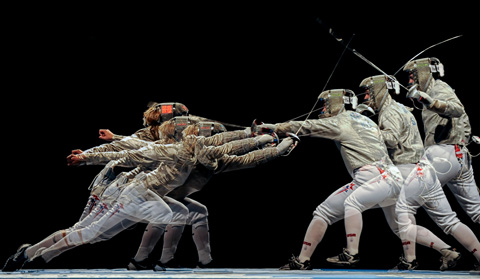

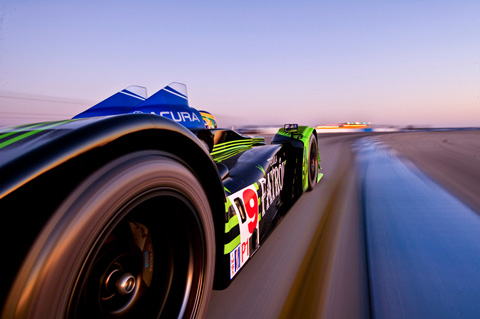
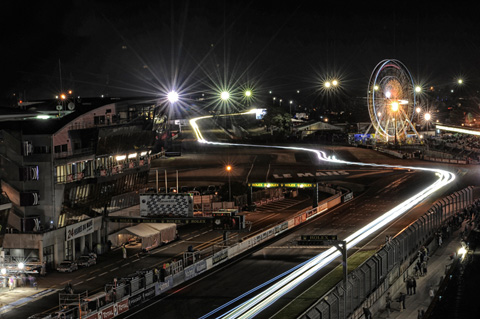
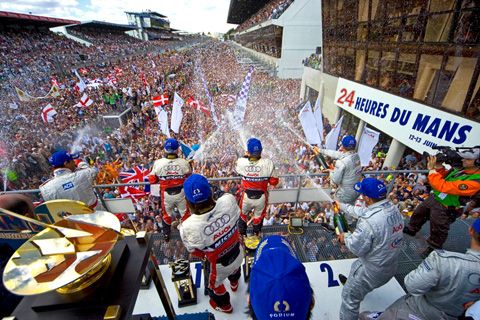
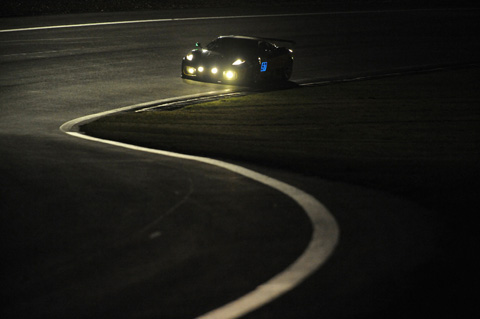
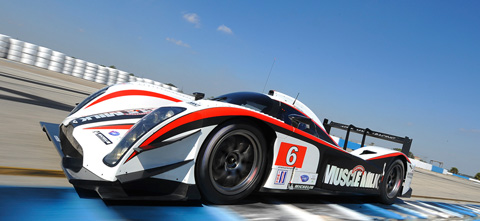
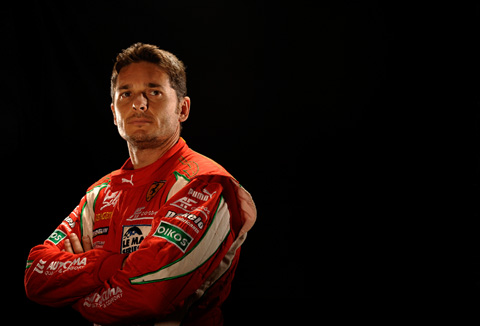
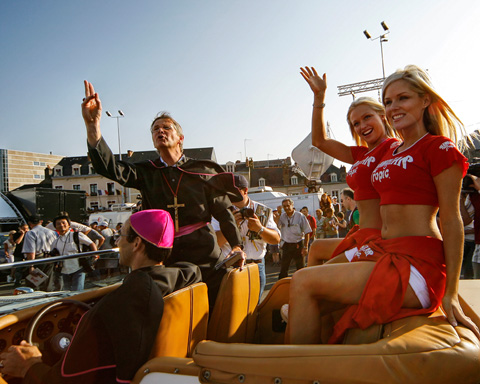
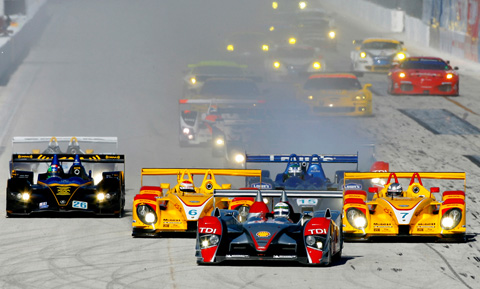
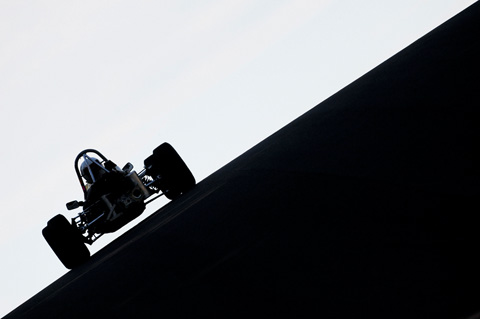
Awesome Rick, love that 4th shot!
Nice insight Rick,thks for sharing,must admit when I get to race event Ilook to see where the photogs are and head in the opposite direction……..
Your blog is really helpful! many many thanks for sharing this nice post!
He is cool! really fantastic LAST shot.
Well you really have some grate pictures here.The last but one it’s my favourite. Thanks for those pictures.
Excellent tips, Rick! I was thinking of trying to shoot car racing this summer, but initially panned the idea because it’s “just a bunch of cars”, however your post and subsequent photos on your site have made me see differently, so I’m going to attempt to try it. Thanks! Bookmarked this page for the great tips for later!
Inspiring photos, Rick. They really tell a story (as opposed to the same old boring race car pictures i usually encounter).
Good tips, too!
Thanks for sharing Rick!
Rick,
Excellent advise and wonderfully written! Thanks for giving us the “Rules”! We know that they have to be broken once in a while, but knowing where to start is really, really helpful for us beginners! I tried taking photos of my Granddaughter at her ice skating competition and was not very successful so I’m always looking for good advise!
Thanks again for sharing and your Action Photos are absolutely amazing!
Dennis
Terrific photos, Rick. I really like the sixth one and the last one….very unique. Thanks for listing all your equipment and settings, too. The most often asked questions on Scott’s blog are about those two things! I’d love to shoot motorsports sometime, but we don’t have many of those events here in New England. Maybe someday…..
Thanks for sharing!
–John
Rick,
Thanks for stopping by and offering some of your insights. I second what Ken said; that fourth shot is incredible! Can you share how you took that shot? I also really liked the seventh shot, just awesome!
– Kev
Just amazing shots! Fantastic work!
Great stuff Rick, appreciate the insight into settings.
Rick,
I’ve never shot motor sports, but reading your blog and seeing your wonderful photos has me itching to spend some time at the track. Thanks for an inspirational and educational post.
Trev J.
Kevin,
Thanks for your kinds words. The fourth shot is from the 24 Hours of Le Mans, shot in 2010. It was taken from the top of the press box along the front straight. Camera was on a tripod, and the exposure was about 12 seconds – which was the amount of time the cars first appeared in the frame and left the frame. The more cars in the shot, the better the headlight streak. I think the aperture was f/11. I did of HDR in photoshop to bring out some of the details.
The Muscle Milk Aston Martin shot was taken earlier this year during a test session. I was hanging out the back of a mini van shooting. It was shot with a Nikon 14-24 on a D3s. The race driver, the van driver, and I met just prior to hitting the track and I made sure everyone was on the same page. I made a point to have the van driver off the circuit during this part of the track to insure I could get the blue and white curbing in the frame to help add a sense of speed to the shot. We are probably going about 25 mph for this shot. If I remember correctly, my shutter speed was 1/30th of a second.
– Rick
I agree about finding a different shot. It’s about being unique and having that odd shot out will definitely get you noticed.
That’s a great insight to photographing super fast paced sports like this. Thanks for sharing the valuable info and specs.
Thanks for the tips, Rick! I love the angles and perspectives of the cars you shot up close. And great tip on the aperture settings to use…I was shooting at a wider aperture and a little slower shutter speed at the recent Indy Grand Prix of Alabama before I changed to the settings you mentioned here, and the results were MUCH better!
I love that shot, too, of the priest appearing to give a blessing gesture along with the waving Hawaiian Tropic girls! Great catch!
Great post Rick. Thank you for your insights and tips, makes me appreciate your photography even more!
Great post! I like the one in the S-curve at night!
Thanks for the article, I’m always looking for tips on making my race photographs better. I’m curious if you (or any of the rest of you!) have been to any semi-pro or amateur races, specifically the crap-can races such as 24 Hours of LeMons? There are amazing shots to be had, and for the price of admission, you can wander around in the pits and talk to the drivers/crew/support people.
What shall I say? Just AMAZING! Respect Man!
Great tips for motorsports, Rick. I will be doing some hydroplane races this year and you gave me some ideas. Planning to catch the vintage racing weekend at Watkins Glens as well this fall.
Rick – Great stuff. Great photos.
Rick some really great shots and informative information about shooting motorsports. Its always great to hear from people like you, who shoot certain sports and how they get that certain shot that no one else has. Thats almost the same philosophy that I have. I want to capture the shot that makes me stand out against the rest. That way I can be more noticed. Since you do alot of endurance and prototype motorsports racing, maybe we can meet if you’re in town for our races at the famous Lime Rock Park road course in the hills of CT. Thanks for the tips and some really great shots. Keep up the good work….
I agree with you totally on your advices. You should never get to comfortable and hang around the same spot all day long, it get´s boring for sure.
You´ll never come home with any new pictures either, and then it´s hard to make good progress in your own development as a photographer.
Very nice images, i especially like the one with the car just going in to a s curve taken during the night.